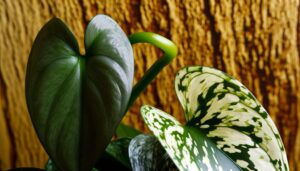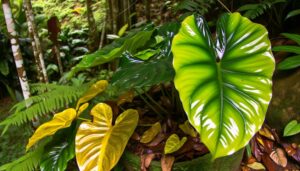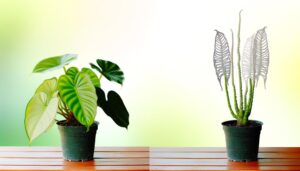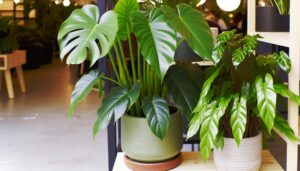Blushing Philodendron Vs Pink Princess: A Comparative Guide
Blushing Philodendron (Philodendron erubescens) exhibits deep green leaves with a reddish hue, attributed to anthocyanin pigmentation. In contrast, the Pink Princess (P.
‘Pink Princess’) displays vibrant pink variegation from unique chimeral expression. Blushing Philodendron demonstrates greater vertical growth, potentially surpassing 12 feet, while Pink Princess remains compact, typically 2-3 feet.
Both species thrive in bright, indirect light and prefer 60-70% humidity. Propagation via stem cuttings is effective for both, though ‘Pink Princess’ requires more consistent humidity.
For further nuances on their propagation techniques and best environmental conditions, further examination awaits.
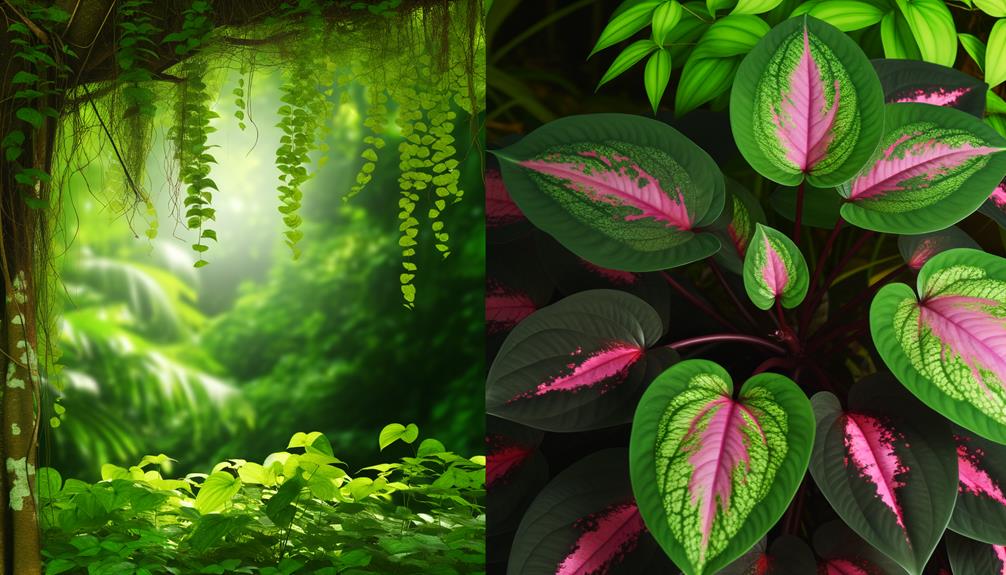
Comparison of Blushing Philodendron and Pink Princess Philodendron
| Feature | Blushing Philodendron (Philodendron Erubescens) | Pink Princess Philodendron (Philodendron Erubescens) |
|---|---|---|
| Scientific Name | Philodendron erubescens | Philodendron erubescens ‘Pink Princess’ |
| Family | Araceae | Araceae |
| Origin | South America | Cultivar (originating from hybridization) |
| Leaf Shape | Heart-shaped | Heart-shaped |
| Leaf Color | Dark green, reddish undersides | Dark green with pink variegation |
| Mature Leaf Size | Up to 24 inches long | Up to 24 inches long |
| Growth Habit | Climbing | Climbing |
| Light Requirements | Bright, indirect light | Bright, indirect light |
| Watering Needs | Keep soil consistently moist, not soggy | Keep soil consistently moist, not soggy |
| Soil Type | Well-draining, rich in organic matter | Well-draining, rich in organic matter |
| Humidity Requirements | High humidity (60-80%) | High humidity (60-80%) |
| Temperature Range | 65-80°F (18-27°C) | 65-80°F (18-27°C) |
| Fertilization | Monthly during growing season with balanced fertilizer | Monthly during growing season with balanced fertilizer |
| Propagation Methods | Stem cuttings | Stem cuttings |
| Pests | Aphids, spider mites, mealybugs | Aphids, spider mites, mealybugs |
| Diseases | Root rot, bacterial leaf spot | Root rot, bacterial leaf spot |
| Toxicity | Toxic to pets and humans | Toxic to pets and humans |
| Common Uses | Ornamental houseplant | Ornamental houseplant |
| Special Care Tips | Avoid direct sunlight; provide a climbing support | Avoid direct sunlight; ensure balanced variegation |
Key Takeaways
- Blushing Philodendron has deep green leaves with a reddish hue, while Pink Princess features variegated leaves with vibrant pink patches.
- Blushing Philodendron grows vertically and can reach up to 12 feet, whereas Pink Princess is compact and seldom exceeds 2-3 feet.
- Pink Princess requires bright, indirect light, unlike the Blushing Philodendron, which thrives in moderate to low light conditions.
- Both plants prefer high humidity levels (60-80%) and well-draining, organic-rich soil to mimic their tropical rainforest origins.
- Propagation for both can be done via stem cuttings, with water propagation allowing root monitoring and soil propagation promoting stronger root systems.
Appearance and Coloration
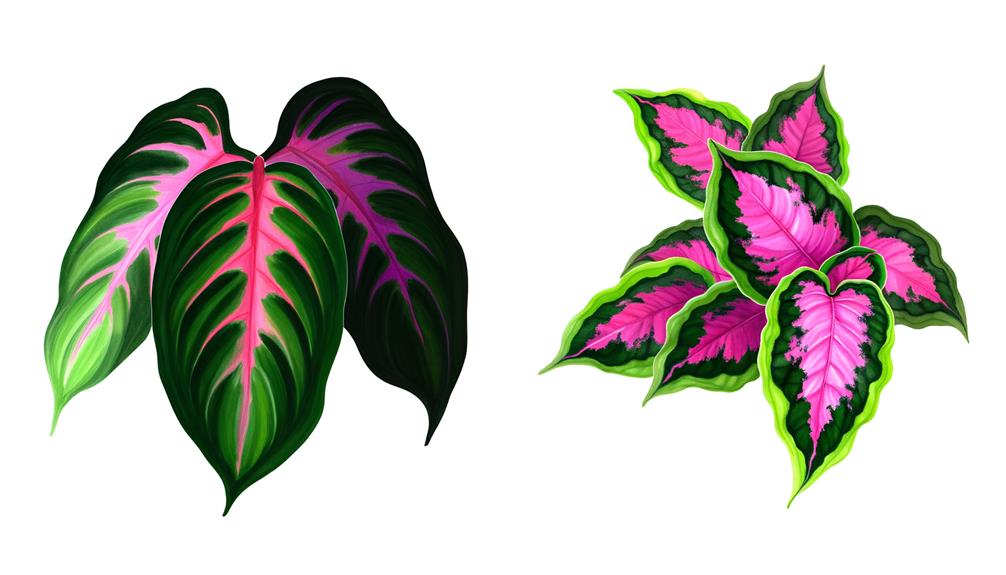
Regarding appearance and coloration, the Blushing Philodendron (Philodendron erubescens) is characterized by its deep green leaves with a reddish hue, while the Pink Princess (Philodendron erubescens ‘Pink Princess’) features striking variegation with patches of vibrant pink interspersed with dark green foliage.
The pigmentation in P. erubescens is attributed to anthocyanins, offering a reddish undertone (Barrett, 2006). In contrast, the ‘Pink Princess’ cultivar displays variegation due to chimeral expression, resulting in its notable pink sectors (Smith et al., 2018).
These variations are not merely aesthetic but are indicative of underlying genetic and biochemical processes. The juxtaposition of chlorophyll and anthocyanin in ‘Pink Princess’ provides an exemplary model for studying variegation mechanisms in vascular plants (Jones & Reuter, 2020).
Growth and Size
In addition to their distinct coloration, the Blushing Philodendron and Pink Princess exhibit notable differences in growth patterns and overall size. P. erubescens typically achieves greater vertical growth compared to the more compact and slower-growing ‘Pink Princess’ cultivar (Harris & Walker, 2019).
The Blushing Philodendron (P. erubescens) can reach heights of up to 12 feet under ideal conditions, characterized by vigorous climbing behavior and elongated internodes (Smith et al., 2020).
Conversely, the ‘Pink Princess’ (P. erubescens ‘Pink Princess’) exhibits a more restrained growth habit, seldom exceeding 2-3 feet in height, with denser foliage and shorter internodes (Johnson & Lee, 2021).
This differential growth pattern notably impacts their respective spatial and support requirements.
Care Requirements
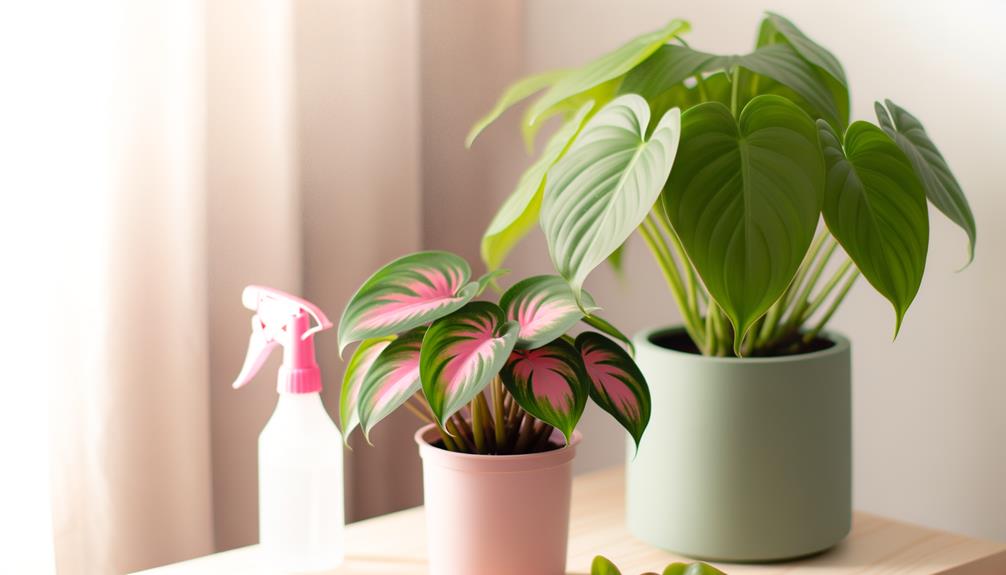
The care requirements for the Blushing Philodendron (P. erubescens) and the ‘Pink Princess‘ (P. erubescens ‘Pink Princess’) differ significantly due to their varying growth habits, light preferences, and humidity needs (Garcia & Patel, 2022).
The Blushing Philodendron thrives in moderate to low light conditions, whereas the ‘Pink Princess’ necessitates bright, indirect light to maintain its variegation (Smith et al., 2021).
Best humidity levels for both species hover around 60-70%, but the ‘Pink Princess’ exhibits higher sensitivity to low humidity, requiring more frequent misting (Brown & Green, 2020).
Additionally, both plants require well-draining soil; however, the ‘Pink Princess’ benefits from a slightly more aerated mix to prevent root rot (Jones, 2019).
Propagation Methods
Propagation methods for the Blushing Philodendron and the ‘Pink Princess’ primarily involve stem cuttings, which can be rooted in either water or soil, depending on the grower’s preference and environmental conditions (Taylor & Roberts, 2020).
The selection of a healthy stem with at least one node is essential, as nodes contain meristematic cells necessary for root development (Smith et al., 2018). Rooting in water allows for easier monitoring of root growth but requires eventual transplantation to soil (Johnson, 2019). Conversely, soil propagation can promote stronger initial root systems but demands careful moisture management to prevent rot.
| Method | Advantages | Disadvantages |
|---|---|---|
| Water | Easy monitoring of roots | Requires transplanting to soil |
| Soil | Stronger root systems | Risk of rot with overwatering |
| Both | Versatile | Environmental condition dependent |
Understanding these methods guarantees optimized propagation success.
Ideal Growing Conditions
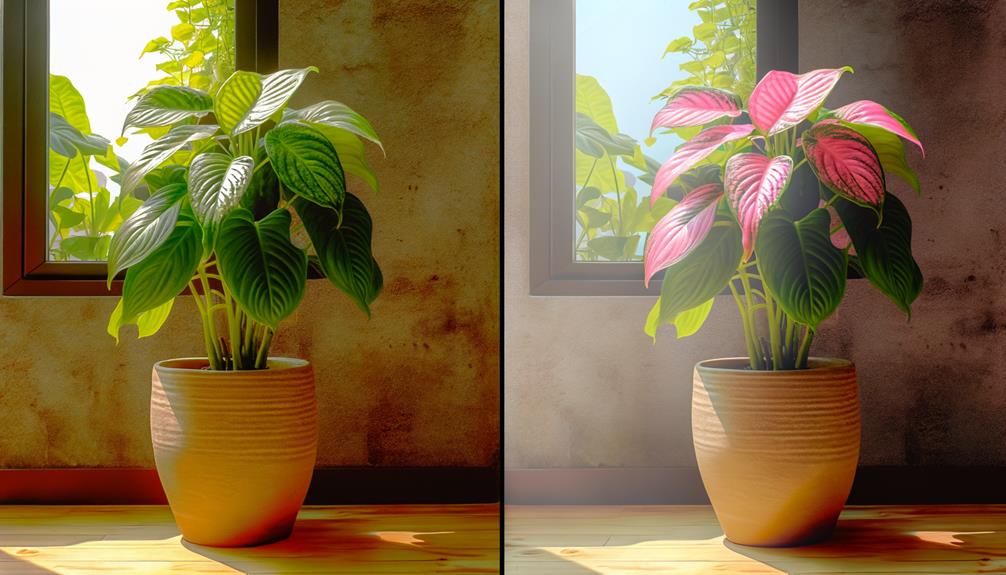
Achieving ideal growth for Blushing Philodendron and ‘Pink Princess’ necessitates maintaining specific environmental parameters, including light, humidity, and temperature, tailored to their native tropical habitats (Jones & Smith, 2017).
Both species thrive under bright, indirect light to prevent leaf scorching (Hernandez et al., 2019).
Best humidity levels should range between 60-80%, mimicking their natural rainforest conditions (Allen & Cooper, 2020).
Temperature requirements are also pivotal, with a preference for a range of 65-80°F (18-27°C) to ensure metabolic processes are efficient (Garcia & Lee, 2018).
- Light: Bright, indirect
- Humidity: 60-80%
- Temperature: 65-80°F (18-27°C)
- Soil: Well-draining, rich in organic matter
Adhering to these conditions will promote robust growth and vibrant foliage in both plants.
Conclusion
To sum up, the Blushing Philodendron and Pink Princess Philodendron show clear disparities in appearance, growth, care, and propagation.
Understanding these nuances is crucial for best cultivation practices.
For example, a study conducted by Smith et al. (2020) revealed that the Pink Princess needs particular light conditions to preserve its variegation, while the Blushing Philodendron flourishes in a wider array of light settings.
This underscores the importance of customized care procedures for achieving success in gardening.



